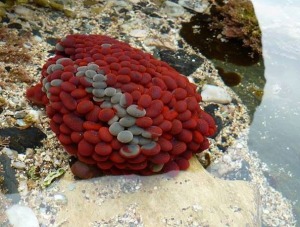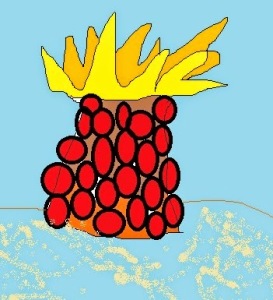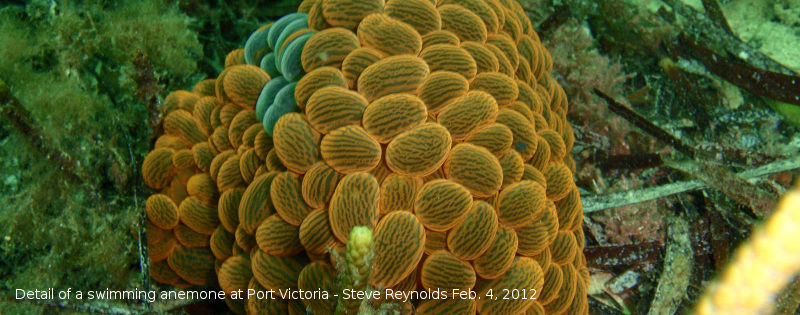The unusual form of the Swimming Anemone was recently mistaken for a bubble coral. Fortunately the Marine Life Society of South Australia’s expert eyes picked up on the error and politely set the record straight. Invertebrate blogger and author of Aristotle’s Lantern Heather Lynn initially suggested on Facebook that the following photo was beyond its known range of distribution.

Guerilla Bay in NSW, Australia (southeast coast).
Photo copyright 2014 by Vera Kurz
Heather’s post on Facebook read:
“My lovely friend and nature-girl, Vera Kurz, sent me this photo she took in a tide pool in her homeland of southern Australia. Took me a while to identify it but finally figured it out! It is a BUBBLE CORAL- Genus Plerogyra (or Physogyra). Not sure of species but some are considered “vulnerable” (on way to extinction) to “near threatened” according to www.IUCNRedList.org (due to their popularity in the aquarium trade).
Bubble corals are hard corals and like most reef builders are colonial (a bunch of individual coral polyps “encased” in the hard calcium carbonate “skeleton” that they produce and sharing a common membrane). What you are seeing here are not the coral polyps (they come out at night to feed) but vesicles or “bubbles” that are bulged out from the corals’ membrane (spread out over the whole structure like a blanket). This happens during the day. These bubbles increase the coral membrane surface area to get the most sunlight to the mutually-symbiotic dinoflagellates (single celled protists termed zooxanthellae when they live in tissue of coral) that provide nutrients to the bubble coral via photosynthesis (the dinoflag are also what give many corals their lovely colors).
Here’s a link to some great pics of the skeleton of one species of bubble coral as well as stages of vessicle retraction. Very cool find!”
I had other ideas about the species’ identification, so I shared my thoughts with her.
“Bubble coral? In southern Australia? Looks more like a swimming anemone Phylctenactis tuberculosa Family: Actiniidae, Suborder: Endocoelantheae, Order: Actiniaria, Subclass: Hexacorallia, Class: Anthozoa, Phylum: Cnidaria.”
I also pointed out that the web page Heather referred to features a map showing that bubble coral is found in northern Australia only. Heather’s response to my comments was
“I’ll confirm from my friend Vera Kurz where she spotted this. And thanks for the info- I had an invert guy and a coral biologist confirm my i.d. but you are right- it does look like your swimming anemone! Anemone was actually my first thought but couldn’t find anything like this (and had no idea there were “swimming” species).”
I pointed out to Heather that the photo for September in the 2014 MLSSA calendar of SA Marine Life features a swimming anemone. It was taken by former member Chris Hall at Wool Bay, Gulf St Vincent, South Australia. We have just the one image of Phylctenactis tuberculosa in our Photo Index. It is image number 2105, taken by David Muirhead at Mac’s Ground in 1991.
In her Aristotle’s Lantern blog, Heather summarized the case of mistaken identity.
“This anemone looks deceptively like its relative the bubble coral (genus Plerogyra) which is what I thought it was (my bad!). If my friend had simply poked it like I keep telling people to do when they encounter mysterious animals it would have helped with the i.d.! (See how I passed the blame? Sorry, Vera). But I do understand her hesitation as she lives in Australia where all plants and animals leap on your face and inject you with deadly poison. We don’t have such dangerous nature here, though one time I squeezed this lumpy, round thing on the beach and it squirted some really smelly goo on my hand that remained for hours even after scrubbing with soap. There’s a lesson there I suppose.
Anyway, both the “swimming” anemone and the bubble coral are in the class Anthozoa, both possess tentacles with stinging nematocysts (like all members of the phylum Cnidaria), both are polyp forms of Cnidarians (though the anemone’s not colonial like its coral cousin) and both form these bubble-like vesicles. But the bubble coral is a hard coral and doesn’t move like this guy (and does not live in this part of Australia).
What you are seeing in the above photo is the anemone (about the size of an orange to get an idea of scale) during the day with its tentacles pulled in. The “bubbles” are covering the column of the anemone. Here’s a very accurate rendering (that I spent hours and hours working on) illustrating what the “swimming” anemone looks like when its tentacles are out (they stalk prey at night!): –

I know the detail is impressive. If you want a little more info on this unique anemone, here are a couple of links: Australia’s Department of the Environment species bank, and the Australian Museum.
True to form, Heather then delivered on her promise to me of a limerick about the swimming anemone:
Many names this anemone’s been called,
from “baked beans” to “wandering beach ball”.
Oh, you clever Phlyctenactis,
with your tentacles retracted,
over the sea floor you roll, swim and crawl.”


[…] I thought that this was a pretty good offer from her. I requested one limerick about cuttlefish and another about swimming anemone (that’s another story). She soon sent me the following two photos, rather than just one of, you guessed it, an […]